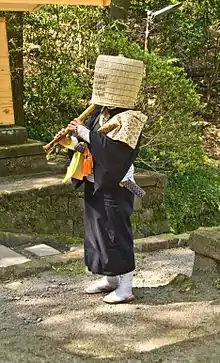Honkyoku
Honkyoku (本曲, "original pieces") are the pieces of shakuhachi music played by mendicant Japanese Zen monks called komusō. Komusō played honkyoku for enlightenment and alms as early as the 13th century. Honkyoku is part of the practice of suizen (吹禅, "blowing Zen"). The Fuke sect which originated from this practice ceased to exist in the 19th century, after which several shakuhachi guilds were formed, and the verbal and written lineage of many honkyoku continues today, though the music is now often practised in a concert or performance setting.
| Part of a series on |
| Fuke Zen |
|---|
 |
| People |
|
| Philosophy |
| Places |
|
| Topics |
| Literature |
|
| Part of a series on |
| Buddhism in Japan |
|---|
 |
There are many ryū 流, or schools, of honkyoku, each with their own style, emphasis, and teaching methods.
"Motion in honkyoku is significantly static, precisely because of the dominance of the sacred purpose and function, and to a certain extent, it is also subject to breathing meditation, the principle of the suidan - the phrase of one full breath - thus a form of breathing exercise."[1]
Kinko Ryū
In the 18th century, a komusō named Kinko Kurosawa of the Fuke sect of Zen Buddhism was commissioned to travel Japan and collect these musical pieces. Although it is commonly thought that the 36 pieces of the Kinko Ryū Honkyoku repertoire were collected and played by Kinko Kurosawa, these pieces were significantly changed and codified by later generations, including Miura Kindo and others.
- Hifumi—Hachigaeshi no Shirabe 一二三鉢返の調
- Taki-ochi no Kyoku (Taki-otoshi no Kyoku) 瀧落の曲
- Akita Sugagaki 秋田菅垣
- Koro Sugagaki 転菅垣
- Kyūshū Reibo 九州鈴慕
- Shizu no Kyoku 志図の曲
- Kyō Reibo 京鈴慕
- Mukaiji Reibo 霧海箎
- Kokū Reibo 虚空
- a) Kokū Kaete (Ikkan-ryū) 虚空替手 (一関流) b) Banshikichō 盤渉調
- Shin Kyorei 真虚霊
- Kinsan Kyorei 琴三虚霊
- Yoshiya Reibo 吉野鈴慕
- Yūgure no Kyoku 夕暮の曲
- Sakai Jishi 栄獅子
- Uchikae Kyorei 打替虚霊
- Igusa Reibo 葦草鈴慕
- Izu Reibo 伊豆鈴慕
- Reibo Nagashi 鈴慕流
- Sōkaku Reibo 巣鶴鈴慕
- Sanya Sugagaki 三谷菅垣
- Shimotsuke Kyorei 下野虚霊
- Meguro-jishi 目黒獅子
- Ginryū Kokū 吟龍虚空
- Sayama Sugagaki 佐山菅垣
- Sagari Ha no Kyoku 下り葉の曲
- Namima Reibo 波間鈴慕
- Shika no Tōne 鹿の遠音
- Hōshōsu 鳳将雛
- Akebono no Shirabe 曙の調
- Akebono Sugagaki 曙菅垣
- Ashi no Shirabe 芦の調
- Kotoji no Kyoku 琴柱の曲
- Kinuta Sugomori 砧巣籠
- Tsuki no Kyoku 月の曲
- Kotobuki no Shirabe 寿の調
At least three additional pieces were later added to the Kinko-Ryu repertoire:
- Kumoi Jishi 雲井獅子
- Azuma no Kyoku 吾妻の曲
- Sugagaki 菅垣
Other notable Honkyoku schools:
| School | Founder |
| Chikuho Ryū | Sakai Chikuho I 初世酒井 竹保 |
| Chikushinkai (Dokyoku) | Watazumi Doso 海童道祖 / Yokoyama Katsuya 横山 勝也 |
| Jikishō Ryū | Tajima Tadashi 田嶋直士 |
| Mu Ryû | Miyata Kohachiro 宮田耕八朗 |
| Myoan Shinpo Ryū | Ozaki Shinryu 尾崎真龍 |
| Nezasa Ha / Kimpu Ryū | Kurihara (Einosuke) Kinpu 栗原錦風 |
| Seien Ryū | Kanemoto Seien 兼友西園 |
| Taizan Ha | Higuchi Taizan 樋口対山 |
| Tozan Ryū | Nakao Tozan 中尾都山 |
| Ueda Ryū | Ueda Hodo 上田芳憧 |
Notes
- Shakuhachi Meditation Music, a 1997 CD release from Sounds True, features 13 selections from the Kinko Ryū, performed by Stan Richardson.[2]
References
- Matoušek, Vlastislav. "Specifics of the Musical Language of Fuke Honkyoku". shakuhachi.cz.
- Shakuhachi Meditation Music, Stan Richardson. Boulder, Colorado: Sounds True (1997) (liner notes)